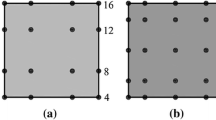Abstract
The frequency-domain fast boundary element method (BEM) combined with the exponential window technique leads to an efficient yet simple method for elastodynamic analysis. In this paper, the efficiency of this method is further enhanced by three strategies. Firstly, we propose to use exponential window with large damping parameter to improve the conditioning of the BEM matrices. Secondly, the frequency domain windowing technique is introduced to alleviate the severe Gibbs oscillations in time-domain responses caused by large damping parameters. Thirdly, a solution extrapolation scheme is applied to obtain better initial guesses for solving the sequential linear systems in the frequency domain. Numerical results of three typical examples with the problem size up to 0.7 million unknowns clearly show that the first and third strategies can significantly reduce the computational time. The second strategy can effectively eliminate the Gibbs oscillations and result in accurate time-domain responses.









Similar content being viewed by others
References
Beskos DE (1997) Boundary element methods in dynamic analysis: part II (1986–1996). Appl Mech Rev 50(3):149–197
Costabel M (2004) Encyclopedia of computational mechanics. In: Stein E, de Borst R, Hughes TJR (eds) Time-dependent problems with the boundary integral method. Wiley, New York
Schanz M, Antes H (1997) Application of ‘operational quadrature methods’ in time domain boundary element methods. Meccanica 32(3):179–186
Banjai L, Schanz M (2012) Wave propagation problems treated with convolution quadrature and BEM. Lecture Notes in Applied and Computational Mechanics 63:145–184
Aimi A, Diligenti M, Frangi A, Guardasoni C (2012) A stable 3D energetic Galerkin BEM approach for wave propagation interior problems. Eng Anal Boundary Elem 36(3):1756–1765
Ahmad S, Manolis GD (1987) Dynamic analysis of 3-D structures by a transformed boundary element method. Comput Mech 2: 185–196
Polyzos D, Tsepoura KG, Beskos DE (2005) Transient dynamic analysis of 3-D gradient elastic solids by BEM. Comput Struct 83:782–792
Phan AV, Gray LJ, Salvadori A (2010) Transient analysis of the dynamic stress intensity factors using SGBEM for frequency-domain elastodynamics. Comput Methods Appl Mech Eng 199(45–48):3039–3050
Ding J, Ye W (2004) A fast integral approach for drag force calculation due to oscillatory slip stokes flows. Int J Numer Methods Eng 60(9):1535–1567
Simões I, Simões N, Tadeu A, Reis M, Vasconcellos CAB, Mansur WJ (2012) Experimental validation of a frequency domain BEM model to study 2D and 3D heat transfer by conduction. Eng Anal Boundary Elem 36(11):1686–1698
Moreno P, Ramirez A (2008) Implementation of the numerical laplace transform: a review. IEEE Trans Power Deliv 23(4): 2599–2609
Kausel E, Roësset JM (1992) Frequency domain analysis of undamped systems. J Eng Mech 118(4):721–734
Humar JL (2002) Dynamics of structures, 2nd edn. Balkema, Rotterdam
Phan AV, Guduru V, Salvadori A, Gray LJ (2011) Frequency domain analysis by the exponential window method and SGBEM for elastodynamics. Comput Mech 48(5):615–630
Xiao J, Ye W, Cai Y, Zhang J (2012) Precorrected FFT accelerated BEM for large-scale transient elastodynamic analysis using frequency-domain approach. Int J Numer Methods Eng 90(1): 116–134
Sanz JA, Bonnet M, Domínguez J (2008) Fast multipole method applied to 3-D frequency domain elastodynamics. Eng Anal Boundary Elem 32:787–795
Tong MS, Chew WC (2009) Multilevel fast multipole algorithm for elastic wave scattering by large three-dimensional objects. J Comput Phys 228(1):921–932
Chaillat S, Bonnet M, Semblat JF (2008) A multi-level fast multipole BEM for 3-D elastodynamics in the frequency domain. Comput Methods Appl Mech Eng 197:4233–4249
Benedetti I, Aliabadi MH (2010) A fast hierarchical dual boundary element method for three-dimensional elastodynamic crack problems. Int J Numer Methods Eng 84(9):1038–1067
Yan ZY, Zhang J, Ye W (2010) Rapid solution of 3-D oscillatory elastodynamics using the pFFT accelerated BEM. Eng Anal Boundary Elem 34(11):956–962
Messner M, Schanz M (2008) Adaptive cross approximation in an elastodynamic boundary element formulation. PAMM 8: 10309–10310
Isakari H, Niino K, Yoshikawa H, Nishimura N (2012) Calderon’s preconditioning for periodic fast multipole method for elastodynamics in 3D. Int J Numer Methods Eng 90(4):484–505
Chaillat S, Semblat J, Bonnet M (2012) A preconditioned 3-D multi-region fast multipole solver for seismic wave propagation in complex geometries. Commun Comput Phys 11(2):594–609
Chen LY, Chen JT, Hong HK, Chen CH (1995) Application of Cesaro mean and the L-curve for the deconvolution problem. Soil Dyn Earthq Eng 14(5):361–373
Chen JT, Chen CH (1998) Analytical study and numerical experiments for Laplace equation with over specified boundary conditions. Appl Math Modell 22:703–725
Fujiwara H (1998) The fast multipole method for the integral equations of seismic scattering problems. Geophys J Int 133(3):773–782
Takahashi T, Nishimura N, Kobayashi S (2003) A fast BIEM for three-dimensional elastodynamics in time domain. Eng Anal Boundary Elem 27:491–506
Saad Y, Schultz MH (1986) GMRES: a generalized minimal residual algorithm for solving nonsymmetric linear systems. SIAM J Sci Stat Comput 7(3):856–869
Banjai L, Messner M, Schanz M (2012) Runge-Kutta convolution quadrature for the boundary element method. Comput Methods Appl Mech Eng 245–246(3):90–101
Acknowledgments
JX and LW were supported by the NSFC under Grant 11102154 and 11074201, and the New Teacher Fund for Doctor Station from the Chinese Ministry of Education under Grant 20106102120009. WY was supported by Hong Kong Research Grants Council under Competitive Earmarked Research Grant 621411.
Author information
Authors and Affiliations
Corresponding author
Rights and permissions
About this article
Cite this article
Xiao, J., Ye, W. & Wen, L. Efficiency improvement of the frequency-domain BEM for rapid transient elastodynamic analysis. Comput Mech 52, 903–912 (2013). https://doi.org/10.1007/s00466-013-0852-9
Received:
Accepted:
Published:
Issue Date:
DOI: https://doi.org/10.1007/s00466-013-0852-9




